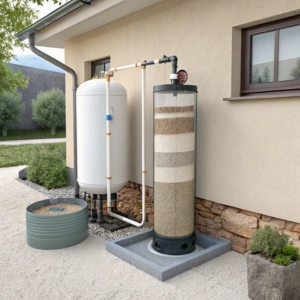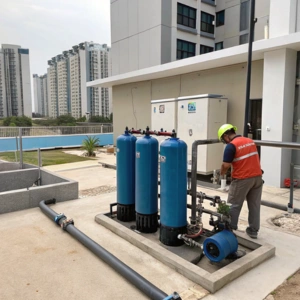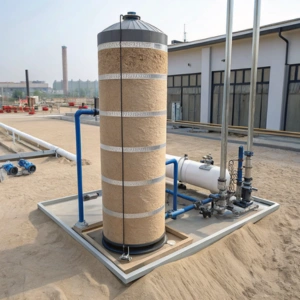Sand Filter for Borewell Water
Borewell water often contains clay, mud, silt, and suspended solids, which cause turbidity, clog pipes, and damage expensive RO membranes. If your borewell water looks cloudy or leaves sediment deposits, a sand filter is the most effective solution. It acts as the first stage of water treatment, protecting your entire filtration system and reducing maintenance costs.
What is a Sand Filter for Borewell Water?
Unlike basic filters that only target specific impurities, Industrial RO Systems ensure comprehensive purification by removing dissolved salts, bacteria, and heavy metals, making them the most reliable solution for industries requiring high-quality water.
How Does a Sand Filter Work?

Multi-Layer Filtration:
Water passes through layers of sand and gravel, which trap clay, silt, and other suspended solids.
Gravity or Pressure Filtration
Operates under pressure for high-flow applications like apartments and industries.
Backwashing Process
Essential for Borewell Water: Especially if TDS > 300 ppm or water shows visible sediment.
Key Benefits of Sand Filters
Removes Turbidity & Dirt: Clears cloudy water caused by clay and suspended solids.
Handles High Sediment Load: Perfect for borewell water with heavy contamination.
Low Maintenance: Requires only backwashing every few weeks.
Long Life: Sand media lasts 12–18 months with proper care.
Suitable for Large Volumes: Ideal for apartments, villas, and industrial plants.
Protects RO Membrane & Appliances: Reduces clogging, extends system life, and cuts maintenance costs.
Applications of Sand Filters

Domestic Homes
Prevents clogging of RO filters and plumbing systems.

Apartment Complexes
Used in centralized water treatment plants.

Industries
Pre-treatment for cooling towers, boilers, and process water systems.
Types of Sand Filters for Borewell Water
Pressure Sand Filters (PSF)
Enclosed systems designed for high-pressure, high-flow filtration. Best for apartments and industries.
Gravity Sand Filters
Simple, open systems commonly used in rural and low-pressure setups.
Sand Filter vs Cartridge Filter – Which One to Choose?
| Feature | Sand Filter | Cartridge Filter |
|---|---|---|
| Best For | Heavy sediment load | Low sediment levels |
| Maintenance | Backwashing every 15–30 days | Cartridge change every 6 months |
| Flow Rate | High (ideal for large setups) | Low (ideal for small homes) |
Installation Tips for Sand Filters
1
Install at the first stage of water treatment (before RO or softener).
2
Ensure inlet pressure of 2.5–3 kg/cm² for efficient operation.
2
3
Provide a drain line for backwashing.
4
Use a multiport valve for easy backwash and rinse cycles.
4
Maintenance Guide
Backwash every 15–30 days (or as soon as you notice pressure drop).
Replace sand media every 12–18 months.
Clean inlet strainers and valves periodically to maintain performance.
Frequently Asked Questions
Why do I need a sand filter for borewell water?
Borewell water often contains mud, silt, and suspended solids. A sand filter removes these particles, preventing clogging and extending the life of your RO system.
Can a sand filter make water drinkable?
No. A sand filter only removes dirt and turbidity. For safe drinking water, use RO + UV treatment after the sand filter.
How often should I backwash my sand filter?
Every 15–30 days, depending on sediment load in your borewell water.
Does a sand filter reduce TDS or hardness?
No. It only removes suspended particles. Use RO for TDS reduction and a softener for hardness.
Which is better for borewell water – sand filter or cartridge filter?
Sand filters are better for high sediment loads and larger setups. Cartridge filters work for homes with low sediment.
How long does the sand media last?
12–18 months with proper backwashing.
Where should I install a sand filter?
At the first stage of water treatment, before RO and softener systems.
